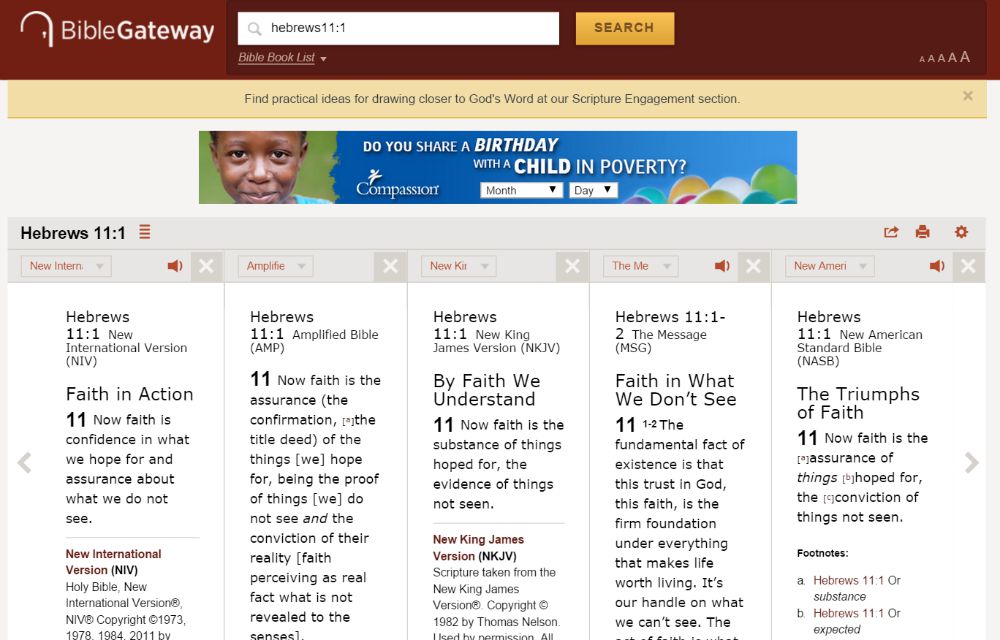 I Do Not Think it Means What You Think it Means
I Do Not Think it Means What You Think it Means
In The Princess Bride, the evil mastermind, Vizzini, says, “He didn’t fall? INCONCEIVABLE.” Inigo Montoya, the master swordsman, replies: “You keep using that word. I do not think it means what you think it means.”
We’ve all used words that we later find out mean something quite different from what we thought they meant. I want to explore the meaning of “faith” as a way to introduce a powerful Bible study tool that you probably already use – but maybe not in this way.
Bible Gateway – a Gateway Tool to Understanding
Bible Gateway is this awesome resource that offers many translations of the Bible in one place. It also provides study guides, commentaries, Bible reading plans, on-demand audible scripture, and a daily scripture – FREE.
These are all good, but one feature of BibleGateway has made this my “go to” resource for understanding the language in a particular passage of scripture: the parallel view of different translations of scripture.
The Parallel View of Different Translations
As part of my delight time with God this morning, I read Hebrews 11. Like most of us, I have a favorite translation of the Bible and that is what I read every day. After reading a verse many times, it is so easy to just let it run through our minds, like water over a rock – not making much of an impression. But this morning I read the Passion translation:
Now faith brings our hopes into reality and becomes the foundation needed to acquire the things we long for. It is all the evidence required to prove what is still unseen. Hebrews 11:1 (Passion Translation)
Is faith really evidence? The evidence required to prove what is still unseen? How can that be?
Steps to Use the Parallel Translations Tool
1. Look up the scripture. I went to BibleGateway.com and looked up Hebrews 11:1 in the NIV, which I usually read.
2. Add Parallel Translations. Then I clicked on the “Add Parallel” button above and selected another translation. I repeated this until I had five translations on the page, side by side. I looked at these five translations: New International Version (NIV), Amplified Bible (AMP) , New Living Translation (NLT), The Message Bible (MSG), and the New American Standard Bible (NASB). [Hebrews 11:1, parallel translations.]
3. Put Together a Meaning from the Translations. Compare the language in the translations and put the key words together in a phrase or sentence.
Example: Defining faith using multiple translations:
Faith is: confidence (NIV, NLT), assurance (AMP, NASB), substance (PT)
of things
we hope for, expect
the assurance (NIV, NLT), conviction (NASB), evidence (PT), proof (AMP)
of things
we do not see, can’t see, not seen.
The Amplified Bible summarizes: “faith is perceiving as real fact what is not revealed to the senses.”
Look at the translations (in the graphic above or here). Can you see what I did? I took language from all the translations and put it together in one sentence to give a fuller, richer meaning to the scripture.
Some translations are word-for-word (e.g. NIV, NASB). Others focus on the function of the original words in modern day meaning – thought-for-thought (e.g NLT, Good News). I find that using multiple translations of both types makes scripture “come alive” for me. So what does “faith” mean?
Faith is Perceiving
Faith isn’t what a lot of us think it is. It isn’t blind! And it isn’t us “trying” to do anything. It is based on knowing: being assured, being convicted – faith is based on evidence!
That evidence is revealed to us, not to our physical man (our senses), but to our spirit man (our hearts). Faith is knowing in our spirits. It is knowing something because God told us! It is knowing because we have experienced and know God.
As I thought more deeply about this meaning, I was reminded that:
Faith comes by hearing and hearing by the word of God. Romans 10:17
In the original language of this scripture, “word” is not “logos” – the written Word of God (the Bible). The Greek word used is “rhema” – the spoken word of God. This is a personal word. This is God speaking to you and I.
We perceive what we cannot see because God shows it to us. He reveals it. So how should you respond when you need faith for something, but don’t have it?
Your thoughts? I would love to hear from you!
P.S. I hope this exploration of the meaning of faith was helpful. But the primary reason I wrote this post was to show you how powerful studying parallel versions of scripture can be in understanding the Bible. Try it and let me know your experience!!


Speak Your Mind